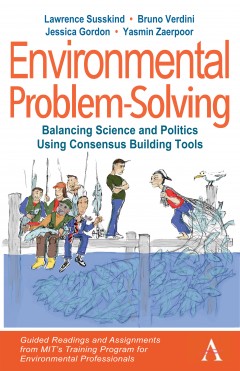Environmental Problem-Solving: Balancing Science and Politics Using Consensus Building Tools
Guided Readings and Assignments from MIT’s Training Program for Environmental Professionals
By Lawrence Susskind
Bruno Verdini
Jessica Gordon
Yasmin Zaerpoor
Other Formats Available:
- About This Book
- Reviews
- Author Information
- Series
- Table of Contents
- Links
- Podcasts
About This Book
The book is divided into four sections: The first section focuses on how certain environmental problems can only be solved through active government efforts to implement policies that effectively take science and politics into account. This section introduces readers to foundational concepts, including the steps in the US federal environmental policy-making process, and offers an action-oriented analysis of how environmental policy gets implemented and how practitioners can use comparative analysis of public policy in environmental problem-solving. It concludes with questions about the possibility of a unified theory of environmental policy making. The section empowers readers to develop, through carefully designed assignments, a framework to shape an action plan to solve specific environmental problems.
The next section focuses on formulating a sound philosophical basis for taking action in environmental problem-solving situations. This includes a discussion of several ethical frameworks that practitioners can use to underpin the actions they propose. This section begins with a general overview of environmental ethics, and then moves to a discussion of utilitarianism versus intrinsic value, deep green approaches to environmental problem-solving, the debate over sustainability versus economic growth, and how science and indigenous knowledge can be applied in a wide range of environmental problem-solving situations. The section empowers readers to take a stand on these debates, drawing on practical cases with worked examples.
The penultimate section helps environmental practitioners understand how to use various analytical tools. It includes a quick survey of traditional and non-traditional evaluation techniques, discussing the strengths and weaknesses of each, focusing on environmental impact assessment, cost-benefit analysis, ecosystem services analysis, risk assessment, simulation and modeling, and scenario planning. This section prepares readers to practice multi-party environmental problem-solving, and to identify the power of each tool to enhance environmental problem-solving, developing the judgment to enumerate strengths and weaknesses as they see them playing out in practice.
The concluding section is a survey of the theory and practice behind mobilizing support for particular problem-solving efforts. It includes discussions of democratic decision-making and environmental problem solving, how the public can be brought in as a partner, methods of collaborative decision-making, the idea of consensus building, and how politics and power sway collective action efforts.
Reviews
“This remarkable book contains everything you need to teach a rich, dynamic course on the practical and theoretical dimensions of environmental policy as well as to evaluate your students’ work. It integrates classic readings, commentaries, scenarios and assignments, along with videos of talks by faculty and presentations by students.” —Judith E. Innes, Professor Emerita, Department of City and Regional Planning, University of California Berkeley, USA
“Developed in the classroom of MIT's Department of Urban Studies and Planning, this is the long-awaited textbook for introductory environmental policy courses at both undergraduate and graduate levels. It includes a number of essential reading materials authored by leading scholars that will provide a framework for analyzing the substance and processes of environmental policy. It also comes with scenario-based exercises, suggested assignments, exam questions and even sample answers. It is a must-have volume for all instructors around the world.” —Masahiro Matsuura, Professor, Meiji University, Graduate School of Governance Studies, Tokyo, Japan
Author Information
Dr. Lawrence Susskind is Ford Professor of Urban and Environmental Planning and Head of the Environmental Policy and Planning Group at MIT. One of the founders of the field of environmental dispute resolution, he has been teaching at MIT and Harvard for almost 50 years.
Dr. Bruno Verdini is Lecturer in Urban Planning and Negotiation at MIT, Affiliated Faculty at the Program on Negotiation at Harvard Law School, and Assistant Director of the MIT Science Impact Collaborative. His research focuses on energy transition, infrastructure development, and ecosystem restoration.
Dr. Jessica Gordon holds a PhD in Environmental Policy and Planning at MIT. Her research and work is on issues related to climate change, environmental policy, and sustainable development.
Dr. Yasmin Zaerpoor holds a PhD in Environmental Policy and Planning at MIT. Her research and work is on issues related to sustainable urban development in the global South, transboundary water governance, and negotiation.
Series
Anthem Environment and Sustainability Initiative
Table of Contents
Links
Stay Updated
Information
Latest Tweets



